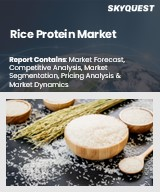
|
시장보고서
상품코드
1646320
세계의 쌀 시장 규모, 점유율, 성장 분석 : 제품별, 유형별, 유통 채널별, 지역별 - 산업 예측(2025-2032년)Rice Market Size, Share, Growth Analysis, By Product (Long-grain, Medium-grain), By Type (Brown Rice, Indica Rice), By Distribution Channel, By Region - Industry Forecast 2025-2032 |
||||||
쌀 시장 규모는 2023년 2,937억 8,000만 달러로 평가되었습니다. 또한, 2024년 3,014억 2,000만 달러에서 2032년 3,701억 3,000만 달러로 성장할 것으로 예상되며, 예측 기간(2025-2032년) 동안 2.6%의 연평균 복합 성장률(CAGR)을 나타낼 전망입니다.
쌀은 세계적으로 연간 7억 톤 이상이 생산되며, 아시아를 중심으로 세계 인구의 절반 이상을 먹여 살리는 중요한 식량입니다. 옥수수 다음으로 중요한 곡물 작물인 쌀 재배는 2021-2022년 칼리프 시즌에 킨타르당 1,940 루피로 인상된 인도의 최저 지원 가격(MSP)과 같은 정부의 이니셔티브에 의해 강화되고 있습니다. 패스트푸드 시장은 소비자 습관의 변화에 따라 빠르게 진화하고 있으며, 세계 인구 증가와 가처분 소득 증가로 인해 산업 성장이 더욱 가속화되고 있습니다. 중국과 인도가 세계 생산량의 절반을 차지하고 있습니다. 바스마티와 같은 고급 품종에 대한 수요가 증가하고 있으며, 특히 유럽과 걸프 지역에서 수출 기회가 증가하고 있습니다.
목차
서론
- 조사 목적
- 조사 범위
- 정의
조사 방법
- 정보 조달
- 2차 데이터와 1차 데이터 방법
- 시장 규모 예측
- 시장 전제조건과 제한
주요 요약
- 세계 시장 전망
- 공급과 수요 동향 분석
- 부문별 기회 분석
시장 역학과 전망
- 시장 개요
- 시장 규모
- 시장 역학
- 성장 촉진요인과 기회
- 성장 억제요인과 과제
- Porter의 Five Forces 분석
주요 시장 인사이트
- 중요 성공 요인
- 경쟁 정도
- 주요 투자 기회
- 시장 생태계
- 시장의 매력 지수(2024년)
- PESTEL 분석
- 거시경제 지표
- 밸류체인 분석
- 가격 분석
쌀 시장 규모 : 제품별
- 시장 개요
- Long-grain
- Medium-grain
- Short-grain
쌀 시장 규모 : 유형별
- 시장 개요
- Brown Rice
- Indica Rice
- Black Rice
- Red Rice
- Bomba Rice
- Arborio Rice
- Parboiled Rice
- Sushi Rice
- Glutinous Rice
- 기타
쌀 시장 규모 : 유통 채널별
- 시장 개요
- 오프라인
- 온라인
쌀 시장 규모
- 북미
- 미국
- 캐나다
- 유럽
- 독일
- 스페인
- 프랑스
- 영국
- 이탈리아
- 기타 유럽
- 아시아태평양
- 중국
- 인도
- 일본
- 한국
- 기타 아시아태평양
- 라틴아메리카
- 브라질
- 기타 라틴아메리카
- 중동 및 아프리카
- GCC 국가
- 남아프리카공화국
- 기타 중동 및 아프리카
경쟁 정보
- 주요 5개사 비교
- 주요 기업의 시장 포지셔닝(2024년)
- 주요 시장 기업이 채택한 전략
- 시장 최근 동향
- 기업의 시장 점유율 분석(2024년)
- 주요 기업 개요
- 기업 개요
- 제품 포트폴리오 분석
- 부문별 점유율 분석
- 매출 전년대비 비교(2022-2024년)
주요 기업 개요
- SunRice(Ricegrowers Limited)(Australia)
- KRBL Limited(India)
- Wilmar International(Singapore)
- Olam International(Singapore)
- Ebro Foods(Spain)
- LT Foods Limited(India)
- Chaman Lal Setia Exports Ltd.(India)
- Amira Nature Foods Ltd.(United Arab Emirates)
- V.A.P Foods Ltd.(India)
- Sarawak Oil Palms Berhad(Malaysia)
- T.K. Group of Industries(Bangladesh)
- Asia Golden Rice Co., Ltd.(Thailand)
- Capital Rice Co., Ltd.(Thailand)
- Riceland Foods(United States)
- Louis Dreyfus Company(Netherlands)
- Siam Rice Export Co., Ltd.(Thailand)
- Galaxy Rice Mills(Pvt) Ltd.(Pakistan)
- Doguet's Rice Milling Company(United States)
- American Rice, Inc.(United States)
결론과 추천 사항
LSH 25.03.04Rice Market size was valued at USD 293.78 billion in 2023 and is poised to grow from USD 301.42 billion in 2024 to USD 370.13 billion by 2032, growing at a CAGR of 2.6% during the forecast period (2025-2032).
Rice is a vital staple, produced globally at over 700 million metric tonnes annually, feeding more than half of the world's population, primarily across Asia. As the second most significant cereal crop after maize, rice cultivation is bolstered by government initiatives such as India's minimum support price (MSP), which increased to INR 1,940 per quintal for the 2021-2022 Kharif season. The market for fast food is rapidly evolving due to changing consumer habits, and the industry's growth is further fueled by increasing global population and disposable incomes. China and India dominate rice production, accounting for half of global output. Export opportunities flourish with rising demand for premium varieties like basmati, particularly from European and Gulf nations.
Top-down and bottom-up approaches were used to estimate and validate the size of the Rice market and to estimate the size of various other dependent submarkets. The research methodology used to estimate the market size includes the following details: The key players in the market were identified through secondary research, and their market shares in the respective regions were determined through primary and secondary research. This entire procedure includes the study of the annual and financial reports of the top market players and extensive interviews for key insights from industry leaders such as CEOs, VPs, directors, and marketing executives. All percentage shares split, and breakdowns were determined using secondary sources and verified through Primary sources. All possible parameters that affect the markets covered in this research study have been accounted for, viewed in extensive detail, verified through primary research, and analyzed to get the final quantitative and qualitative data.
Rice Market Segments Analysis
Global Rice Market is segmented by Product, Type, Distribution Channel and region. Based on Product, the market is segmented into Long-grain, Medium-grain and Short-grain. Based on Type, the market is segmented into Brown Rice, Indica Rice, Black Rice, Red Rice, Bomba Rice, Arborio Rice, Parboiled Rice, Sushi Rice, Glutinous Rice and Others. Based on Distribution Channel, the market is segmented into Offline and Online. Based on region, the market is segmented into North America, Europe, Asia Pacific, Latin America and Middle East & Africa.
Driver of the Rice Market
The rice market is significantly influenced by government interventions, particularly through subsidies and trade restrictions. When governments provide financial support to rice farmers, it tends to boost production levels, resulting in a higher supply and consequently lower prices. Conversely, reducing these subsidies can lead to diminished production and increased prices. Additionally, governments may implement import or export restrictions, including tariffs or quotas, which can limit international trade of rice. Such measures directly impact global supply and demand dynamics, ultimately contributing to fluctuations in rice prices, highlighting the critical role of regulatory actions in shaping the rice market landscape.
Restraints in the Rice Market
The rice market faces significant constraints due to limited land availability, which hampers efforts to scale up production in response to increasing demand. This restriction not only risks driving up prices and triggering supply shortages but also poses sustainability challenges for rice farming practices. Farmers may be compelled to adopt intensive farming methods or convert natural land for cultivation, risking soil degradation and diminishing biodiversity. Additionally, these land limitations can intensify the adverse impacts of climate change on rice yields, further complicating the industry's ability to provide sufficient supplies while maintaining environmental health and resilience.
Market Trends of the Rice Market
The rice market is witnessing a notable upward trend as demand for specialty rice varieties surges, driven by increasing consumer health consciousness. Specialty rice, known for its enhanced nutritional profiles, higher fiber content, and richer vitamin and mineral composition, is increasingly favored over conventional milled white rice. This shift reflects a broader dietary trend toward healthier, whole-food options. Among these, Basmati rice stands out as a premium choice, with India dominating the global export market, capturing an impressive 85% share of top-tier Basmati rice. This trend indicates a robust growth opportunity for specialty rice producers and exporters alike.
Table of Contents
Introduction
- Objectives of the Study
- Scope of the Report
- Definitions
Research Methodology
- Information Procurement
- Secondary & Primary Data Methods
- Market Size Estimation
- Market Assumptions & Limitations
Executive Summary
- Global Market Outlook
- Supply & Demand Trend Analysis
- Segmental Opportunity Analysis
Market Dynamics & Outlook
- Market Overview
- Market Size
- Market Dynamics
- Drivers & Opportunities
- Restraints & Challenges
- Porters Analysis
- Competitive rivalry
- Threat of substitute
- Bargaining power of buyers
- Threat of new entrants
- Bargaining power of suppliers
Key Market Insights
- Key Success Factors
- Degree of Competition
- Top Investment Pockets
- Market Ecosystem
- Market Attractiveness Index, 2024
- PESTEL Analysis
- Macro-Economic Indicators
- Value Chain Analysis
- Pricing Analysis
Global Rice Market Size by Product & CAGR (2025-2032)
- Market Overview
- Long-grain
- Medium-grain
- Short-grain
Global Rice Market Size by Type & CAGR (2025-2032)
- Market Overview
- Brown Rice
- Indica Rice
- Black Rice
- Red Rice
- Bomba Rice
- Arborio Rice
- Parboiled Rice
- Sushi Rice
- Glutinous Rice
- Others
Global Rice Market Size by Distribution Channel & CAGR (2025-2032)
- Market Overview
- Offline
- Online
Global Rice Market Size & CAGR (2025-2032)
- North America (Product, Type, Distribution Channel)
- US
- Canada
- Europe (Product, Type, Distribution Channel)
- Germany
- Spain
- France
- UK
- Italy
- Rest of Europe
- Asia Pacific (Product, Type, Distribution Channel)
- China
- India
- Japan
- South Korea
- Rest of Asia-Pacific
- Latin America (Product, Type, Distribution Channel)
- Brazil
- Rest of Latin America
- Middle East & Africa (Product, Type, Distribution Channel)
- GCC Countries
- South Africa
- Rest of Middle East & Africa
Competitive Intelligence
- Top 5 Player Comparison
- Market Positioning of Key Players, 2024
- Strategies Adopted by Key Market Players
- Recent Developments in the Market
- Company Market Share Analysis, 2024
- Company Profiles of All Key Players
- Company Details
- Product Portfolio Analysis
- Company's Segmental Share Analysis
- Revenue Y-O-Y Comparison (2022-2024)
Key Company Profiles
- SunRice (Ricegrowers Limited) (Australia)
- Company Overview
- Business Segment Overview
- Financial Updates
- Key Developments
- KRBL Limited (India)
- Company Overview
- Business Segment Overview
- Financial Updates
- Key Developments
- Wilmar International (Singapore)
- Company Overview
- Business Segment Overview
- Financial Updates
- Key Developments
- Olam International (Singapore)
- Company Overview
- Business Segment Overview
- Financial Updates
- Key Developments
- Ebro Foods (Spain)
- Company Overview
- Business Segment Overview
- Financial Updates
- Key Developments
- LT Foods Limited (India)
- Company Overview
- Business Segment Overview
- Financial Updates
- Key Developments
- Chaman Lal Setia Exports Ltd. (India)
- Company Overview
- Business Segment Overview
- Financial Updates
- Key Developments
- Amira Nature Foods Ltd. (United Arab Emirates)
- Company Overview
- Business Segment Overview
- Financial Updates
- Key Developments
- V.A.P Foods Ltd. (India)
- Company Overview
- Business Segment Overview
- Financial Updates
- Key Developments
- Sarawak Oil Palms Berhad (Malaysia)
- Company Overview
- Business Segment Overview
- Financial Updates
- Key Developments
- T.K. Group of Industries (Bangladesh)
- Company Overview
- Business Segment Overview
- Financial Updates
- Key Developments
- Asia Golden Rice Co., Ltd. (Thailand)
- Company Overview
- Business Segment Overview
- Financial Updates
- Key Developments
- Capital Rice Co., Ltd. (Thailand)
- Company Overview
- Business Segment Overview
- Financial Updates
- Key Developments
- Riceland Foods (United States)
- Company Overview
- Business Segment Overview
- Financial Updates
- Key Developments
- Louis Dreyfus Company (Netherlands)
- Company Overview
- Business Segment Overview
- Financial Updates
- Key Developments
- Siam Rice Export Co., Ltd. (Thailand)
- Company Overview
- Business Segment Overview
- Financial Updates
- Key Developments
- Galaxy Rice Mills (Pvt) Ltd. (Pakistan)
- Company Overview
- Business Segment Overview
- Financial Updates
- Key Developments
- Doguet's Rice Milling Company (United States)
- Company Overview
- Business Segment Overview
- Financial Updates
- Key Developments
- American Rice, Inc. (United States)
- Company Overview
- Business Segment Overview
- Financial Updates
- Key Developments



















